Target Kite
Imitates
Plane's Flight
By ARTHUR GRAHAME
Drawings by STEWART ROUSE
THE Army and the Navy have reached
back 3,000 years into history for something
to improve the shooting eye of their
air gunners.
It's a kite -- one that performs maneuvers
no kite ever performed before. When
the war is over it is going to be the delight
of kids from seven to 70. A quarter of a
million of the kites have already been produced
for machine gunners to rip apart,
and production is still going on.
This kite will dive, loop, and bank
sharply. It will plummet like a stricken
airplane hurtling earthward with its engine
at full power. It will recover with all the
ease of a pilot hauling back on his stick,
and race for altitude.
The Navy's kite -- it was developed by
the Navy and then adopted by the Army
-- is called the best air-gunnery target in
the world. It was perfected by Paul
Edward Garber, who probably knows more
about kites than anyone else and who
might be called the champion kite flyer
of five continents.
As curator of aviation at the Smithsonian
Institution in Washington, D. C., he (Cont'd.)
| 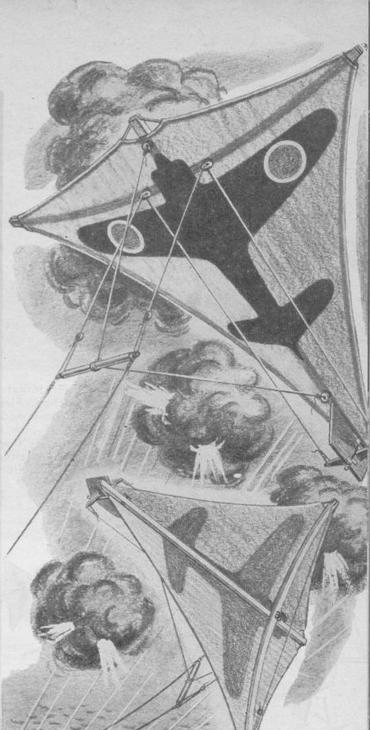 |
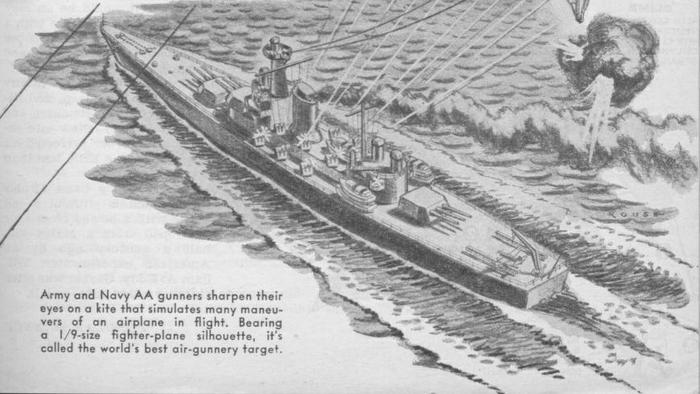 |
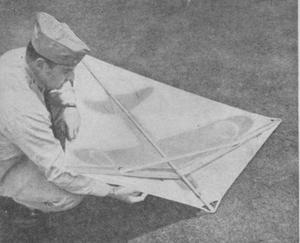
TARGET KITE used in enemy waters
(left) is made with an aluminum-alloy
frame that sinks when shot
down. No floating wrecks of kites
are thus left behind to tip off the
enemy to the presence of our ships.
|
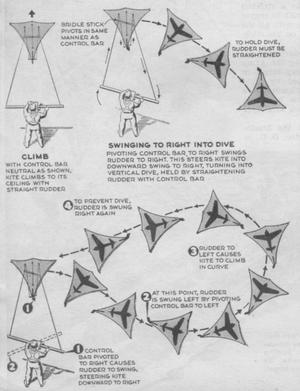
FAMILIAR DESIGN. The remarkable air target has the traditional
kite shape but is of durable construction. Five feet, one inch
high, with a wing span of five feet, the standard model weighs under
two pounds. Bolted to the mast -- of 3/4 by 3/4-inch spruce, pine, or
basswood -- is a 1¾ by 3/8-inch spar, nine inches from the fop. The
cover is plastic-treated rayon. Maneuvers are effected through a
control bar, as shown below, from the ground or from a ship's deck.
|
was custodian of the museum's
kite collection, which ranged
from weird oriental kites representing
gods and demons to
the box kite capable of carrying
a man aloft, invented by
Lawrence Hargrave, of England.
Garber knew that kites, notably
a type invented by Alexander
Graham Bell of telephone
fame, had exerted a profound
influence on early airplane
design. He had studied
kite shapes and their flying
qualities from information covering
a period of 30 centuries.
Shortly after the United
States entered the war, Garber,
now a lieutenant commander
in the Special Devices Division
of the Navy's Bureau of Aeronautics,
heard Admiral John
H. Towers remark that one of
the things the Navy needed
most was an improved moving
target to speed up the training
of aircraft gunners.
Garber tucked that remark
away in his head. At that time,
he was helping with the production
of millions of model
airplanes needed by the armed
services for recognition instruction.
Garber kept thinking about
targets. A kite might do. It
would be cheap, easy to produce.
But if it was stationary
in the air it would be an easy
mark for even a novice with a
gun. What was needed was one
that would do aerobatics and
dodge bullets.
Working in hours mostly
stolen from his sleep, and assisted
by Lloyd Reichert and
Stanley Potter, fellow kite enthusiasts,
Garber perfected his
target kite in a little less than
a year.
He used as a basis for his
kite -- which is without a tail
-- one with a bowed cross spar
developed from a Malay kite
half a century ago by an
American experimenter, William
A. Eddy. Garber was after
stability; this kite had it.
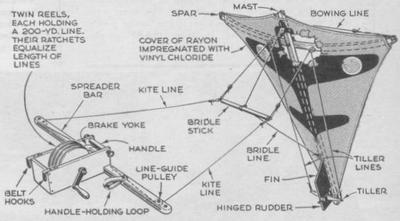
This control mechanism "pilots" the kite. A two-drum wood reel
with brakes is mounted on the four-foot bar. The flying lines ore
led to the kite through the 12-inch-long bridle stick which, with
the keel and dihedral, gives the kite three-dimensional stability.
|
When the wind presses
against the covering fabric,
the lower portion of the kite
becomes a sort of vertical
keel. The bowed spar becomes
a weight-carrier similar to
that of the bony structure of
a bird's wings. Lateral balance
can be destroyed and
restored simply by altering
the air pressure on one side
or the other of the face of the
kite. Garber added a fin near
the lower end of his upright
mast to augment the keel
surface. To this he attached
a rudder, controlled by the kite's operator
by means of twin flying lines.
When he was satisfied with his product,
Garber demonstrated it for Capt. Luis de
Florez, Chief of the Special Devices Division,
who in civilian life is a successful inventor
and consulting engineer. Captain de
Florez watched the kite's spectacular aerobatics
for a few minutes.
"That's fine," he said, with a cheerful disregard
for Navy red tape. "Get 1,500 made
up." Demonstrations to other Navy officers
and to the Army were enough. The Garber
kite was adopted.
The kite must be good. Gunnery officers
are elated when their students hit it once
in 50 shots.
What the target kite will do to peacetime
kite flying is easily imagined. Appropriately,
it is being manufactured for the
armed forces by A. G. Spalding & Bros.,
makers of athletic equipment.
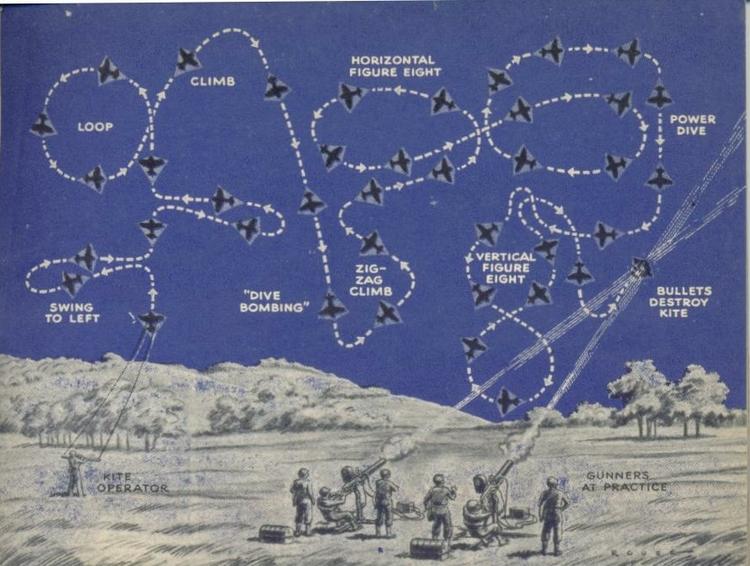
KITE STUNTS. After a half
hour of instruction and a few
hours' practice, an operator can
make this wonder kite perform all
sorts of spectacular aerobatics.
|
Popular Science, May 1945, (pages 65-67)






